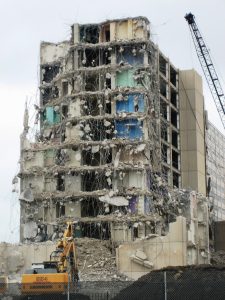
Picture from https://creativecommons.org/licenses/by-sa/2.0/
I got back to the Chicagoland area and found my Sunday paper, the one weekly paper that gets tossed onto the driveway outside my stolid, gray brick house. The lead story is titled, “Leaderless gangs vex efforts to stop killing.” The article’s complex and I don’t want to oversimplify what has been happening. The rising Chicago death toll cannot fit into a blog post. The fact that police are making fewer stops due to greater paperwork and accountability demands affects crime statistics a great deal, for example, but I don’t wish to go in this direction today.
A big idea stopped my quick read and connected me to education briefly: At least part of the current crisis was blamed on the lack of leadership and leadership structure within current gangs. The gangs have become diffuse, dispersed organizations with no obvious head, and consequently have become much more difficult for police to address in an organized fashion.
To quote the Chicago News Tribune:
“Two federal law enforcement officers who regularly work with Chicago police on gang violence said that, among the black gangs, the old hierarchical rules of engagement ‘ are nonexistent.’ One of the officers said he traces the change, in part, to the dismantling of public housing high-rises in Chicago.
Without those buildings, the officer said, there was no infrastructure around which to rebuild the gangs the way they used to exist.
‘Public housing scattered,’ he said. ‘You used to have a hierarchy of people who had to live together. You have this big housing event, and GDs are living with Four Corner Hustlers.
They are also going to school with each other. I vividly remember the death of a gang member who had once gone to my school. The community spent a few anxious days waiting to find out if gang activity had been involved, specifically if the Four Corner Hustlers had been sending a message to the Latin Kings. The school spent those days on high alert, ready for lockdown at any time.
Eduhonesty: I recommend this front page Tribune article. I am probably not headed in the directions readers expect, however. I suppose those high rises had to come down. Too many beaten-down people had too many terrifying stories of life in the Cabrini-Green high-rise hallways. But I do not see that the situation seems any less frightening today. Spike Lee’s Chi-Raq and many other newspaper stories headline a neighborhood violence problem that has long since spiraled out of control.
We knocked those high-rises down., Are we better off? We may be worse off.
I’d like to draw an analogy to No Child Left Behind and Race to the Top. Mandating change without providing support works poorly — when it works at all. I believe No Child Left Behind might have produced much better results if the government had actually provided additional funds to keep struggling schools open longer, allowing those schools to provide more desperately needed remedial tutoring for our lowest students. Absent that tutoring and more schooling, however, the program was destined to fail. In the meantime, putting a whole bunch of gang members in low-rise housing scattered throughout neighborhoods seems to be having about the effect I would have expected — those gang members are still selling drugs and shooting people. What did we do to stop the drugs and that violence? We moved people, who took all their guns, drugs and problems with them.
Simple solutions to complex problems hardly ever work well.
